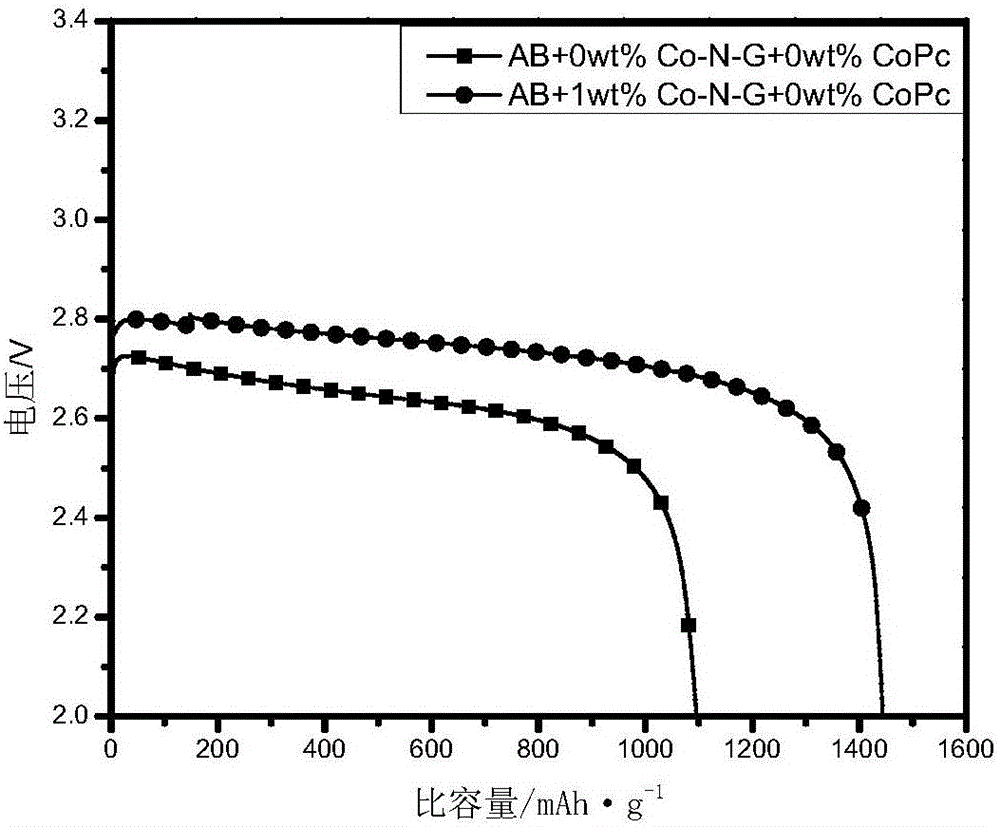Cathode, preparation method thereof and lithium battery employing cathode
A positive electrode and thionyl chloride battery technology, applied in the field of electrochemistry, can solve the problems of catalytic activity attenuation, insoluble in thionyl chloride electrolyte, etc., and achieve the effect of improving discharge voltage, good electrochemical performance, and good catalytic stability
- Summary
- Abstract
- Description
- Claims
- Application Information
AI Technical Summary
Problems solved by technology
Method used
Image
Examples
Embodiment 1
[0065] The preparation method of the positive electrode sheet: acetylene black, PTFE accounting for 8% of the mass of acetylene black, cobalt and nitrogen-doped graphene (Co-N-G) accounting for 1% of the mass of acetylene black are mixed with absolute ethanol, then heated and foamed, rolled Roll forming to obtain a positive electrode sheet.
[0066] In this example, cobalt phthalocyanine CoPc was not added during the preparation of the positive electrode sheet.
[0067] The lithium / thionyl chloride battery is made by using the positive electrode sheet of this embodiment, and the injected electrolyte is LiAlCl of 1.5mol / L 4 / SOCl 2 . The prepared battery was tested at 25mA·cm by a discharge test system at room temperature. -2 Under the condition of discharge to 2.0V.
[0068] After the preparation of the lithium / thionyl chloride battery obtained in this example is completed, at 25mA·cm -2 Under the conditions of the discharge test, the discharge results are as follows fig...
Embodiment 2
[0070] Except that the addition of cobalt and nitrogen-doped graphene accounted for 3% of the mass of acetylene black, other preparation and detection methods and conditions were the same as in Example 1.
[0071] In this example, cobalt phthalocyanine CoPc was not added during the preparation of the positive electrode sheet.
[0072] After the preparation of the lithium / thionyl chloride battery obtained in this example is completed, at 25mA·cm -2 Under the conditions of the discharge test, the discharge results are as follows figure 2 , with 3% Co-N-G added in the positive electrode, its discharge capacity is 1580mAh g -1 , 490mAh·g more than pure acetylene black (AB) -1 , the discharge voltage is 150mV higher than AB.
Embodiment 3
[0074] Except that the addition of cobalt and nitrogen-doped graphene accounted for 5% of the mass of acetylene black, other preparation and detection methods and conditions were the same as in Example 1.
[0075] In this example, cobalt phthalocyanine CoPc was not added during the preparation of the positive electrode sheet.
[0076] After the preparation of the lithium / thionyl chloride battery obtained in this example is completed, at 25mA·cm -2 Under the conditions of the discharge test, the discharge results are as follows image 3 , with 5% Co-N-G added in the positive electrode, its discharge capacity is 1700mAh g -1 , 610mAh·g more than pure acetylene black (AB) -1 , The discharge voltage is 160mV higher than AB.
PUM
| Property | Measurement | Unit |
|---|---|---|
| Discharge capacity | aaaaa | aaaaa |
Abstract
Description
Claims
Application Information
 Login to View More
Login to View More - Generate Ideas
- Intellectual Property
- Life Sciences
- Materials
- Tech Scout
- Unparalleled Data Quality
- Higher Quality Content
- 60% Fewer Hallucinations
Browse by: Latest US Patents, China's latest patents, Technical Efficacy Thesaurus, Application Domain, Technology Topic, Popular Technical Reports.
© 2025 PatSnap. All rights reserved.Legal|Privacy policy|Modern Slavery Act Transparency Statement|Sitemap|About US| Contact US: help@patsnap.com



